|
Food and drink biodiversity:
Seeds and nuts
Seeds are contained in fruits. A nut in the botanical sense
is a seed inside an indehiscent, dry fruit with a hard covering (pericarp). Most
fruits referred to as nuts in a cullinary sense are not true nuts in the
botanical sense. For instance, pistachio and pecan nuts have lines of dehiscence
and are thus not true nuts. The Brazil nut is not a true nut but a seed (a
number of 'Brazil nuts' are contained within a large woody pod).
In a culinary sense, nuts have a hard covering with an edible kernel inside
and seeds, by the time you get them to eat, do not have a covering that needs to
be removed and are kernels that can just be eaten straight. Seeds from
legumes are covered separately.
Grains are covered elsewhere and are also a type of dry
fruit.
In this survey of the foods we eat,
legumes, grains, seeds and nuts therefore make up
the foods we eat that are derived from dry, non-succulent fruit or dry seeds in
fruit. There is a separate page on fruits that we know
as fruits in the food sense, i.e. succulent, juicy fruit.
Commercial species
|
Aleurites moluccana (Candlenut)
Family:
Euphorbiaceae
The Candlenut tree in native to SE Asia and grows to a
height of about 12 to 15 m. It yeilds large nuts that are used in Indonesian
and Malay cooking, either as whole nuts, as a paste, or using oil extracted
from them. It is essential that the nuts are cooked or roasted before being
consumed because they are poisonous when raw. Nuts have a high oil content
(c 65%) and the oil is extracted from ripe, roasted nuts to produce cooking
oil, and from half ripe nuts to produce lumbang oil, which is used for
illumination. In southern Africa, Candle-nut trees are cultivated in
Mpumalanga and KwaZulu-Natal and also grow wild as escapees from
cultivation.
|
|
Anacardium occidentale
(Cashew Nut) Family:
Anacardiaceae
Cashew trees are native to Brazil and were distributed
round the world by Portuguese explorers in the 1500's. They are grown
extensively in Mozambique and also in Maputoland (northern
KwaZulu-Natal). Cashew nuts should not be eaten raw because they are
surrounded by a very acrid, irritant oil - this oil is burnt off in the
roasting process. Besides being very tasty, cashews are a good source of
protein (about 17% by weight).
|
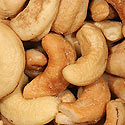 |
|
Arachis hypogaea
(Peanut)
Family: Fabaceae
Groundnuts were domesticated by indigenous people in the region of
Argentina and Bolivia over 4000 years ago. The seedpods mature
underground, hence the name groundnuts. Peanuts are nutritious in that
they contain 45-50% oil and 25-30% protein as well as having certain
vitamins. However, peanuts infested with fungal aflatoxin and eaten in
large quantities can cause liver cancer in people.
|
|
Bertholletia
excelsa (Brazil Nut)
Family: Lecythidaceae
Brazil nut trees are native to the Amazon rain forest in South
America. Trees are about 45 m high and bear woody pods, each pod
containing 12 to 20 hard-shelled seeds that we know as Brazil nuts. Most
Brazil nuts are harvested from wild trees in Brazil and exported. The
kernel of a Brazil nut contains about 67% fat and eating one nut is
about the caloric equivalent of eating an egg! They are a good source of
phosphorus and thiamin and contain some calcium.
|
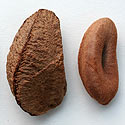 |
|
Carya illinoensis
(Pecan Nut)
Family: Juglandaceae
Indigenous from south-eastern USA through to eastern Mexico. Pecans
were harvested by indigenous North American tribes well before the
arrival of European settlers in the 1500's. They were introduced to
Spain in the 1600's and are now grown in all temperate regions of the
world although the USA remains the main producer. Pecans have a high fat
content (about 71%) but most of it is unsaturated (the more healthy
type). They are an excellent source of phosphorus, thiamin, copper and
zinc, and a good source of iron and potassium.
|
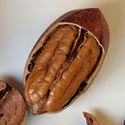 |
Castanea sativa
(Sweet chestnut)
Family: Fagaceae
The indigenous distribution of Sweet chestnut extends from the
Mediterranean to the Caucasus. It was introduced to Great Britain by the
Romans. Chestnut cultivation involves selecting plants with large, tasty
nuts and growing them clonally. The most common use of chestnuts is to
roast them whole and then peel and eat them while they are still warm.
Before roasting, it is important to cut an "x" into the flat side of the
nuts to stop them from exploding. Chestnuts can also be boiled or
steamed. In southern Africa, chestnut trees are grown in moist regions,
usually in gardens and suburbs (e.g. Newlands and Rondebosch suburbs of
Cape Town).
|
|
Cocos nucifera
(Coconut) Family:
Arecaceae
Coconut Palms are native to the Indo-Pacific Ocean region and grow at
the top of beaches, at the limit of wave action. They are now grown in
large plantations and are used for producing many products, such as
coconut oil (from the white endosperm in the coconut), wine (toddy),
spirit (arrack) and coir matting. The white endosperm is used in cooking
and confectionery.
|
|
Corylus (Hazelnut)
Family:
Betulaceae There are about 15 species in the genus, with an indigenous
distribution covering temperate regions of Europe, Asia and North America.
The hazelnuts we eat are derived mainly from two species of tree: the
European hazel Corylus avellana and the Filbert Corylus maxima.
There are also hybrids between the two and hybrids with other Corylus
species. Hazelnuts are an excellent source of magnesium, iron,
phosphorus, potassium and thiamin, and a good source of niacin. Hazelnuts
are eaten raw or roasted and are also used extensively in chocolate making,
baking and cooking. |
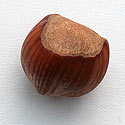 |
Helianthus annuus
(Sunflower) Family:
Asteraceae Sunflowers originate from North America and are now grown
extensively for their seeds which produce vegetable oil that is used in
cooking, salad oils and margarines. The residue after oil extraction
provides a high protein food source for livestock.
|
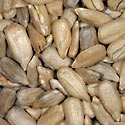 |
Juglans regia
(Walnut)
Family: Juglandaceae
Native to the region in Eurasia extending from the Near East through to
the Himalayas and on to Western China. Walnuts must have been harvested
from earliest times but the earliest records of actual growing of
orchards of walnut trees go back to classical Greek and Roman times.
Besides the nuts, trees are also a source of high quality wood used for
furniture and gunstocks. Growing of walnuts in Europe began in the
1500's. They are now grown worldwide and the largest production is from
California. Walnuts are an excellent source of zinc,
copper, phosphorus and thiamin and a good source of iron and potassium.
Uses Walnuts can be eaten raw or roasted. They are used as an ingredient
in salads, baking and cooking.
|
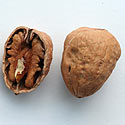 |
|
Macadamia spp.
(Macadamia Nut)
Family: Proteaceae
The Smooth macadamia nut Macadamia integrifolia
and the Rough macadamia nut Macadamia tetraphylla, both
Australian species, have been cultivated for their nuts since
about 1860. Macadamia nuts are now grown in other parts of the
world including Central America and South Africa. The fat content of
Macadamia nuts is high, amounting to about 72%, primarily made up of
monounsaturated fats. They are an excellent source of copper, magnesium
and thiamin and a good source of iron and niacin. They are a popular
snack, eaten be eaten raw or roasted and are also used in salads, baking
and cooking.
|
|
Pistacia vera
(Pistachio Nut)
Family: Anacardiaceae
Pistacia vera is a drought-resistant plant that grows wild in
the Central Asian steppes and has been domesticated to produce plants
with larger nuts. The nut is contained within a shell that splits open
slightly, with an audible pop, when it is ripe. It has a greenish
hue, which is unusual. Domesticated plants bear larger nuts than wild
forms. Pistachio nuts are an excellent source of iron, magnesium,
phosphorus, potassium and thiamin. Fat content stands at 54% by weight
and is made up mainly of monounsaturated fats.
|
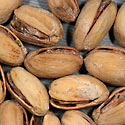 |
Prunus dulcis
(Almond)
Family: Rosaceae
Almonds are believed to have been domesticated about 5000 years ago in the
eastern Mediterranean region. Domestication involved hybridisation among a
number of species and/or varieties and included selecting for plants with
almonds that were not bitter. Bitter almonds contain a cyanide compound -
eaten in small numbers your body is able to metabolize the compound
rendering it harmless but if you eat them in large numbers you can get sick
or die. Almonds are an excellent source of calcium, iron, riboflavin and
Vitamin E. Calcium levels are higher than in any other nut. Almonds are
eaten as a snack and used in many recipes. |
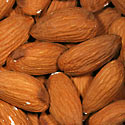 |
Sesamum indicum
(Sesame)
Family: Pedaliaceae
Believed to have been domesticated in India but by 600 BC it was being
cultivated in the Middle East and came to be an important constituent in
Middle Eastern foods (e.g. tahini and halvah). The seeds are eaten. They
have a high oil content (40-60%) and are used to produce sesame oil. Sesame
is cultivated on a small scale in southern Africa and also grows wild (naturalised). |
|
|
Zea mays
(Mielie seeds and Popcorn)
Mielie (corn) kernels are roasted and eaten as a snack.
The seeds of the popcorn variety of Zea mays puff out into popcorn
when they are heated up. |
|
Non-commercial species introduced to southern Africa
Pinus pinea
(Stone pine)
Family:
Pinaceae
Originates from the Mediterranean region of Europe and grown in South
Africa, mainly as a suburban tree. The cones produce large edible nuts,
which in the Western Cape are referred to as
dennepitjies or simply pitjies. Children collect them, crack
them open and eat the soft white kernel. Pine nuts are also used in
middle eastern cooking.
|
|
Indigenous species gathered in southern Africa
Information mainly from van Wyk and Gericke (2000)
Adansonia digitata
(Baobab) Family:
Malvaceae Seeds are eaten fresh or roasted.
They can also be ground into a powder used as a substitute for coffee.
|
|
Brabejum
stellatifolium (Wild almond) Family:
Proteaceae
Produces brown, velvety, almond-like fruit. The seeds are toxic because they
contain cyanogenic glycosides but these can be leached out by placing the
seeds in sacks and running them under water for 'a long time'.
|
|
Leucadendron pubescens (Knokkers) Family:
Proteaceae In the Clanwilliam area of the Western Cape, South Africa,
the pea-sized seeds are collected from wild female plants and eaten as nuts.
|
|
Schinziophyton rautanenii (Manketti, Mongongo)
Family:
Euphorbiaceae
Native to N Botswana, N Namibia, SE Angola, W Zimbabwe, N Mozambique and
marginally into South Africa, along the Botswana border. Has egg-shaped
velvety fruit consisting of a thin fleshy layer around a thick, hard shell
containing a nut. Both fruit and nut are edible and nutritious and have the
advantage of being available for most of the year.
|
|
Sclerocarya birrea
(Marula) Family:
Anacardiaceae
Native to subtropical regions of Africa. Produces rounded, yellow fruit
about 30 mm in diameter, containing a tasty, nutritious pulp as well as a
pip with three oblong nuts that can be cracked open and eaten. The nuts also
contain an oil that is used for various purposes including cooking, as a
moisturiser, and as a baby oil. Marula is being commercially grown, mainly
for the pulp, but not yet on a large scale.
|
|
Sesamum spp.
Family: Pedaliaceae
In addition to the cultivation of domesticated sesame
Sesamum indicum (see above), seeds are harvested from wild Sesamum
species in southern Africa (e.g. Sesamum capense and Sesamum
triphyllum).
|
|
Strelitzia nicolai
(Natal wild banana) Family:
Strelitziaceae Seed capsules contain large black seeds with orange,
oily arils. Seeds are ground into a flour, which is mixed with water and
made into a fritter. The arils are pushed into the fritter and it is then
baked over coals and then eaten. It is evidently a filling meal but not
particularly tasty.
|
|
Ximenia spp. (sourplums)
Both species of Ximenia that occur in southern Africa have fleshy
fruits with hard-shelled pips, each containing a tasty kernel. |
|
Publications
-
Anon. 2002. Encyclopedia of Foods. A Guide to Healthy
Nutrition. Academic Press, San Diego, California.
-
McGee, H. 1991 (first published 1984). On Food and
Cooking. The Science and Lore of the Kitchen. Harper Collins, London.
-
Sauer, J.D. 1993. Historical geography of crop plants - a
select roster. CRC Press, Boca Raton, Florida.
-
van Wyk, B.-E. & Gericke, N. 2000. People's Plants. A
Guide to Useful Plants of Southern Africa. Briza Publications,
Pretoria.
-
Zohary, D. & Hopf, M. 1993. Domestication of plants in the
old World - The origin and spread of cultivated plants in West Asia, Europe,
and the Nile Valley. Clarendon Press, Oxford.
|
